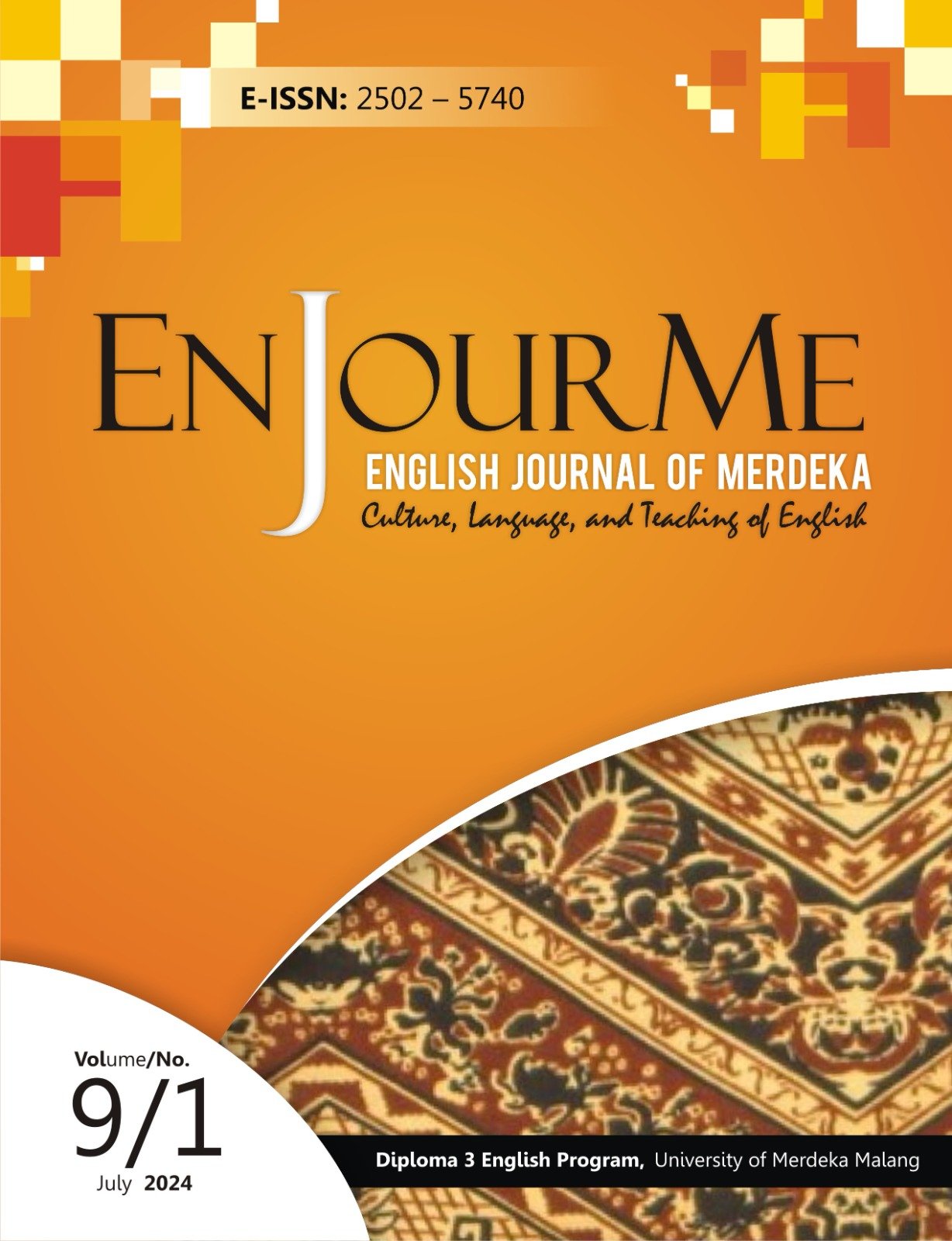The impact of kahoot-based formative assessment on student learning outcomes at a Junior High School in Samarinda
DOI:
https://doi.org/10.26905/enjourme.v9i1.13150Keywords:
Kahoot, Assessment, Learning outcomeAbstract
This study explores the impact of using Kahoot! as a formative assessment tool on student learning outcomes in English at SMPN 22 Samarinda. The research utilized a quasi-experimental design with pre- and post-test measures on Class VII-7 B. Findings revealed that Kahoot! significantly improved students' understanding of English grammar, particularly tenses. Data analysis was conducted using SPSS software, showing a notable increase in student achievement post-intervention. The study emphasizes the importance of integrating technology like Kahoot! in the classroom to enhance learning. Recommendations for future research and teacher strategies are also provided.
Downloads
References
Aljaloud, A. G. (2016). Research trends in student response Research trends in student response. International Journal of Learning Technology, 10, (4), 313–325.
Nataliia V. Iaremenko (2017). Enhancing English Language Learner's Motivation Through Online Games. Information Technologies and Learning Tools, 59, (3), 126-133.
Ayu, K. Y. (2021). Media Sosial Dan Pembelajaran: Study Efektifitas Instagram dalam Pembelajaran Bahasa Inggris. . Pendidikan, Bahasa, Dan Sastra, 7, (2), 375–382.
Bahati, B. F. (2019). Measuring learner satisfaction with formative e-assessment strategies. International Journal of Emerging Technologies in Learning, 14, (7), 61–79.
Beatty, I. &. (2009). Technology-enhanced formative assessment: A research-Based pedagogy for teaching science with classroom response technology . Journal of Science Education and Technology, 18, (2), 146–162.
Bicen H, K. S. (2018). Perceptions of students for gamification approach. Kahoot as a case study, 13, (2), 72-93
Bullón, J. E. (2018). Analysis of student feedback when using gamification tools in math subjects.IEEE Global Engineering Education Conference (EDUCON), 18, 1818- 1823.
Burnstein, R. A. (2001). Using wireless keypads in lecture classes." The Physics teacher. Reprinted with permission from The Physics Teacher, 39, (1), 8-11, 72-93
Falig, N. H. (2020). Kahoot! Quizzes: A Formative Assessment Tool to Promote . Applied Linguistics and Language Research, 7, (4), 1-20.
Fatimah Batool, S. I. (2023). The Effect Of Using Kahoot As Formative Assessment Tool . Positive School Psychology, 7, (4), 2-9.
Hanafiah, N. A. (2023). Collage Media to Develop Fine Motor Skills in Early. Bulletin of Early Childhood, 2, (2) 375-382.
Ismail, M. &. (2017). Kahoot!: A promising tool for formative assessment in medical education. . Education in Medicine Journal, 9, (2), 19–26.
Lestari, N. &. (2022). Penerapan Media Video Conference dalam Pembelajaran. JMKSP (Jurnal Manajemen, Kepemimpinan, Dan Supervisi Pendidikan), 7, (1), 134–140.
Lim, T. K. (2017). Measuring user engagement in mobile classroom response system: a case study. International Conference on Learning and Collaboration Technologies Novel Learning Ecosystems. 10295. 375-388.
Maxine Minton, B. B. (2021). Examining the use of Kahoot to support digital game-based formative assessments in UAE higher education. Studies in Technology Enhanced Learning. 1, (2), 1-33.
Nkhoma, C. N. (2018). Gamifying a flipped first-year accounting classroom using Kahoot! International Journal of Information System and Engineering, 6, (2), 93–115.
Pachler, N. D. (2010). Formative e-assessment: Practitioner Cases. Computers & Education, 54, (3), 715–721.
Parra-Santos, T. M.-J.-P.-L. (2018). Gamification for formative assessment in the framework of engineering learning. The sixth international conference on technological ecosystems for enhancing multiculturality,1. (1) 61-65.
Patronis, M. I.-D. (2019). Attitudes and perceptions towards summative e-assessment for free-text responses a Case Study of a UAE university. International Journal of Information and Communication Technology Education, 15, (1), 13–28.
Plump CM, L. J. (2017). Using Kahoot! in the classroom to create engagement and active learning: A game-based technology solution for eLearning novices, Management Teaching Review. 2 (2) 151-8.
Rodrigues, F. &. (2014). A system for formative assessment and monitoring of students’ progress. Computers and Education, 76, 30–41.
Sánchez-Mena, A. M.-P. (2017). Drivers and barriers to adopting gamification teachers’ perspectives. The Electronic Journal of e-Learning, 15, (5), 434-443.
Shieh, J. &. (2017). Assessment of learning and teaching in higher education a case analysis of a university in the south of Europe. Malta Review of Educational Research, 11, (1), 29–47.
Susilowati, E. (2016). The Effectiveness Of Kahoot In Supporting Grammar Class on Class A Year I Students Academic Year 2016/2017 Of Diploma Iii Of Nursing Ngudi Waluyo University.
Wang, A. &. (2016). The Effect Of Points And Audio On Concentration, Engagement, Enjoyment, Learning, Motivation, And Classroom Dynamics Using Kahoot!, European conference on games based learning 737-748
Wang, A. I. (2015). The wear out effect of a game-based student response system. Computers and Education 82, 217-227.
Additional Files
Published
How to Cite
Issue
Section
License
Authors who publish with this journal agree to the following terms:
(1) Copyright of the published articles will be transferred to the journal as the publisher of the manuscripts. Therefore, the author confirms that the copyright has been managed by the journal.
(2) Publisher of EnJourMe (English Journal of Merdeka) : Culture, Language, and Teaching of English is University of Merdeka Malang.
(3) The copyright follows Creative Commons Attribution–ShareAlike License (CC BY SA): This license allows to Share — copy and redistribute the material in any medium or format, Adapt — remix, transform, and build upon the material, for any purpose, even commercially.




